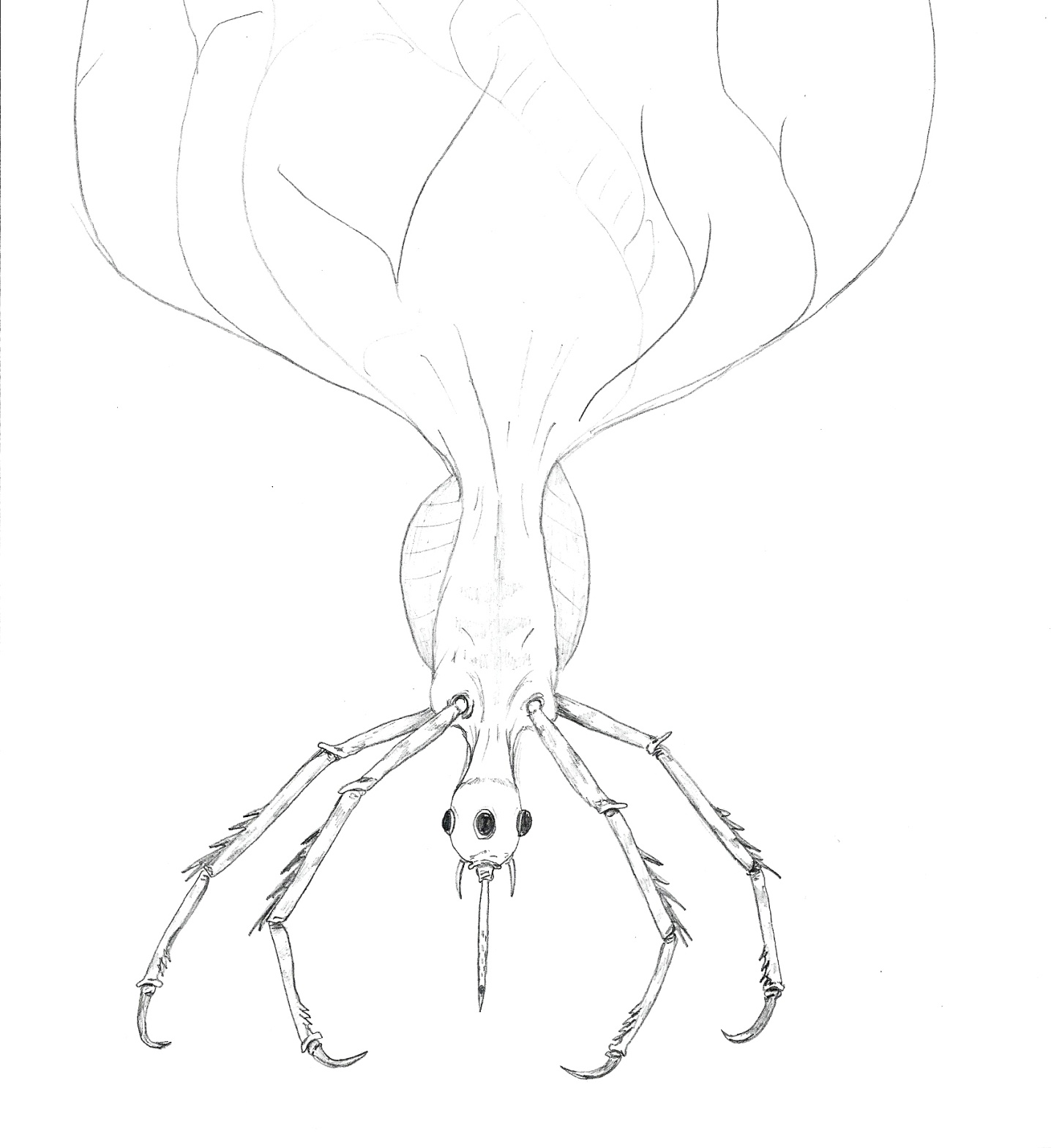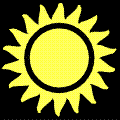Spindizzy
This article originally appeared in the March 2013 issue of Freelance Traveller.
| Wet Lowlands terrain | Gehenna | |||||||
| Qty | Animal | Mass (kg) | Hits | Armor | Wounds and Weapons | |||
|---|---|---|---|---|---|---|---|---|
| 10+3D6 | Spindizzy (Carnivore Flyer) | 1 | 2/1 (explosion if flame or heat present) | None | 2D6 stinger* | A0 | F7 | S3 |
| * +1 per Spindizzy feeding per round. Also injects venom causing 1/4 damage to be permanent to one characteristic | ||||||||
Gehenna has a biosystem unique to known space in that all of the life forms living there are venomous to some degree or another. Some manufacture their own venom and use it offensively, others use it passively or actively as a defense, and others do not use it as either a defensive or offensive weapon but it is merely a byproduct of another use. An example of this is the fascinating, if somewhat repellant and fearsome Spindizzy (terribilis ratis, or “the terrible floater”).
Spindizzys live in the marshy wetlands and swamps of the lowlands. They live in swarms of up to 30 individuals and while not cooperative, they do sometimes rely on their numbers to find and subdue prey when their usual food suppliers, the Heffalump and Madcow, are not around. The Spindizzy survives as do a remarkably wide and thriving population of similar organisms found all across the stars, by feeding on the blood or similar tissues of hosts, but not as full-time parasites. Instead, they feed once and then leave the host to continue about their business until hungry again. Because the Spindizzy cannot eat a large amount of food lest it be weighted down and unable to fly it will try to stay with the host for a protracted period to take several feedings if possible, then float off. It is particularly adapted for this, as we shall see here.
The Spindizzy is a gasbag floater with the head and articulated body hanging head-down from the gasbag. The gasbag, which also contains the gas creating organs, air siphon for propulsion, and a large vane on top, is approximately 1-1.5 meters in diameter. The body containing the expandable lateral stomach sacs, legs, head, and other organs is about 8cm long and 4cm in diameter. The animal has four, long, articulated legs with numerous spurs along them, and terminate in razor sharp hooks. The head hangs from the body in the center of the legs and is a sphere with the mouth on the lowermost side. The Spindizzy has four large compound eyes spaced horizontally and equidistant around the center axis of the head. The mouth consists of a muscular extensible tube surrounding a 3cm long bony proboscis ending in a sharp tip. The needle-like proboscis is hollow and has several small holes along the sides near the first 50mm of the tip. Two large, curved chelicerae on either side of the mouth complete the feeding end of the animal. The color of the Spindizzy ranges from various shades of pale yellowish gray to some banding and patterns of red on the legs and body. The vane on the top of the gasbag makes the Spindizzy spin as it descends, slowing the animal enough to make a more or less controlled descent, in the same manner a monocopter seed, such as those of Terra’s maples, does.
The motion of the Spindizzy is what gives it the name. Like most gasbag floaters, the animal generates a lighter than air gas inside its gas sac, in this case hydrogen, by means of electrolysis. A special organ concentrates salts and metals to act in combination with water the animal drinks to separate the oxygen from hydrogen. The electricity to power the reaction comes from banks of electrically charged organs similar to what it used by animals that stun their prey electrically. Terra’s electric eel is an example. It takes about an hour for a Spindizzy to inflate its gasbag enough to achieve neutral buoyancy, and another hour to achieve flight. During flight, the animal uses a siphon nozzle near the base of the sac to puff air in various directions for steering, or to help it climb. The Spindizzy then slowly descends after the short climb, with the vane standing straight above the gasbag causing the animal to spin as it descends, with its legs splayed out horizontally. A Spindizzy in flight will be seen to bob up a short distance, and then descend with the spinning motion, repeating this motion as it floats across the sky looking for prey or hosts.
If a host or prey is found the swarm will rapidly descend, spinning down very rapidly as they vent gas from their sacs, to land on the animal they have spotted. The Spindizzys do not deflate the sac completely—they just vent enough gas to descend, then clamp onto the prey with their spiny legs to hold themselves there… otherwise they might drift off again. While feeding they generate more gas so once they let go of the prey they just lift away. They have to do this, too, because while they are feeding they take on weight and it has to be compensated for or the Spindizzy won't be able to take off. Otherwise, they are vulnerable to flying predators who swoop down to pick them off a Heffalump’s back.
The Spindizzy’s legs latch tightly into the hide of the animal with the hooks and spurs providing secure purchase while it punches the needle-like proboscis deep into the hide of the host, simultaneously injecting an anti-coagulant and enzymes that both protects the Spindizzy from any defensive venom in the flesh of the prey and numbing the area. This venom also has the property of necrotizing the flesh, thus liquefying it quickly (beginning almost immediately and with excruciating and highly destructive results in humans) so the Spindizzy can quickly begin to suck it up through the proboscis. The main prey of the Spindizzy, the Heffalump, has a 2cm thick hide so the aggressive action of the enzymes helps drill down deeply enough for the Spindizzy to feed on the underlying blubber and blood vessels. The other main prey item, the Madcow, has thick, bristly fur that is almost like dull quills. The numerous spurs and hooks on the Spindizzy’s legs allow it to get a firm grip and force its way into the fur to the surface of the skin without being dislodged by the plunging and rearing a Madcow under Spindizzy assault will perform.
The numbing effect of the venom usually means the Spindizzy feeding will be a minor nuisance to the animal provided the prey is large, and the number of Spindizzys is small. If a human were to come under attack by a swarm that dropped out of the sky and began clamping on and feeding the results would be painful, and if not rapidly fatal, will result in destruction of muscles and bone as the necrotic effect turned them to liquid. This isn’t because the venom the Spindizzy uses is for incapacitating prey, it is merely to aid in feeding by numbing and liquefying the tissues—the severe reaction in humans is due to the scale of the effect that evolved for use on multi-ton animals and a pain reaction to the rapid destruction of nerve and structural tissue.
In game terms, this means Spindizzy bites cause 2D6 in the first round, and 1-point loss for each additional round a Spindizzy is attached and feeding. If the character attacked survives ¼ of the total damage done to characteristics is permanently removed from one random characteristic to reflect the liquefied tissues that are permanently lost either up the proboscis of the Spindizzy or that sloughed off.
Spindizzys are voracious feeders and will not hesitate to drop rapidly onto any prey large enough to support even one of the swarm. For purposes of evasion or defense, the descent rate is equivalent to Speed 3 but the Spindizzy flight is largely dependent on the wind speed and direction, though the animal using the puffing siphon gains some lateral control. Primarily the swarm bobs about looking for prey and descends on the whatever it sees moving that is large enough to feed off of and isn’t so low to the ground that the Spindizzys have no way to rapidly ascend if danger threatens. Not many animals prey on Spindizzys. However, there are some large web-spinning trapper/arthropods and gasbag-slashing predatory flyers that do make a meal out of Spindizzys when they can. The greatest threats to Spindizzys are storms, with their high winds and lightning strikes. The first will scatter the swarm, smashing them into trees and cliff sides, and the latter can them to explode, sometimes causing spectacular chain-detonations across a swarm as their hydrogen-filled gasbags burn in bright flashes.
Gehenna has two short, but extremely violent storm seasons, one in spring and the Fall, when the monsoon storms come racing down the equatorial ridgeline into the lowlands and jungles. The electrical storms are spectacular and tourists come from all over to see them. When the Spindizzys sense the approaching storms they enter into a period of frantic egg-laying activity and burrow into their cliffside nesting holes if they can get to them. Often the egg laying exhausts them and they merely vent their gas sacs and seek cover in the trees. In their nesting holes, the animals deflate their gas sacs and back into the hole to protect themselves from predators that dig them out by presenting their proboscis and fangs at the entrance. Those sheltering in the trees almost entirely die from the high winds battering them to the ground and shredding their gas sacs.
Spindizzys are a hermaphroditic R-strategy animal that lay their eggs on the thick algae mats floating on the pools of the swamps and marshes they live in. One group will lay the eggs by floating across the mats and dropping the eggs as they pass. The eggs are sprayed by the non-egg laying Spindizzys with sperm-laden milt that has a hardening agent to trigger the eggs into encysting to protect the embryonic Spindizzy for the 40-day duration of the storm season. The Spindizzys that lay eggs will be exhausted after laying 200-300 eggs and be too weak to do more than shelter in the trees or drift to the ground. They will die during the storms. The others will act as fertilizers and make it to the nesting holes. These animals will survive to become the following year’s egg layers.
The young hatch 4-5 days after the end of the storm season and feed on the small arthropods and fish that eat the algae mats. The thick mats will protect them from predators. Once they begin to float after two weeks the young become prey to any number of animals living in the marshes and swamps, and of the 200-300 eggs laid by an adult, approx. 20-30 young will reach maturity within 1 month.

 Freelance
Traveller
Freelance
Traveller